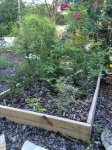I am surprised that noone uses wicking beds for growing out trees. For those who dont know about them, they are simple to make and have some great advantages over other growing beds. They are made of a box, or a hole, with a liner. 10 cm/4" of gravel go in first, and a pvc pipe under or with the gravel, with elbow and verticle piece. On top of the gravel is a layer of shade cloth or landscape fabric. Then 20 cm/8" of whatever soil and compost mix. You only add water to the tube, enough to fill the gravel most of the way. The soil wicks it up from underneath. You dont water as much because you dont loose much. The surface stays dry, so weeds dont germinate nearly as much as normal beds. The roots grow down to a comfortable depth, then spread out. There are open and closed versions that allow rain to fill up to a drain hole to avoid over filling, or in a greenhouse they can be closed. WBs work very very well for veggies, so why not trees? Im working on my greenhouse with WBs and will be putting trees in to see how they do, behind my veggies. When I do, I will make a thread with pics. Til then if you want to know more, just google them. Thats where I learned about them, because theyre better than aquaponics for root crops. I have a small one with lettuce, basil, bell peppers, and chinese cabbage, just to see how it works. And it is a success so far, even in a kinda shady spot. The plants are healthy and growing very nicely. I think its worth trying and finding out how trees do in there too. Its hard to imagine them not working. Getting trees out later should be easy since theyre in a box with plastic liner, and with good soil and with air getting in to the roots, the soil should not compact much. Putting worms in the soil works well too, and with a "bio box", you add organic waste and the worms eat it. Then the fert and make passages for air. Idk yet for sure, but they sound close to perfect.
Btw my trees in my aquaponics grow beds are doing well still after several months, and I think others should try it too. Organic veggies, fish, and trees can all grow together and it waters itself. Again the dry surface doesnt promote much weed growth.
So maybe more folks who didnt know about those two systems would like to try them. If theyre as good for trees as they are for fruits and veggies, you cant go wrong! I use my AP water to fill the gravelbof the WB, further adding great plant food- fish poo. So, give'em a try.

